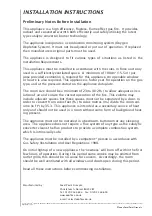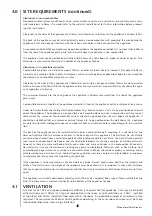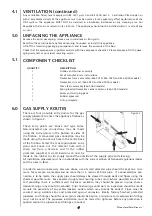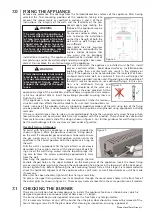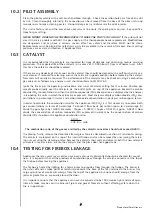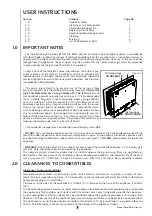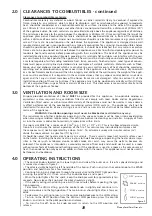
BRIEFING THE CUSTOMER
All instructions must be handed to the user for safekeeping. Show the customer how to light and control
the fire. After commissioning the appliance, the customer should be instructed on the safe use of the appli-
ance and the need for regular servicing. Frequency of service depends on usage, but MUST be carried out
at least once annually.
Advise that cleaning of the fire maybe achieved when the fire is cold using a damp cloth and mild deter-
gent on most surfaces. Advise that the fire will emit a "newness" smell for a time after initial commission-
ing and that extra ventilation may be needed during this time. Recommend that a guard be used for the
protection of the young, pets, the elderly and the infirm.
SERVICING
Isolate the fire from the gas supply. Ensure that the fire is fully cold before attempting service. A sug-
gested procedure for servicing is detailed below.
1. Lay out the dustsheet and tools.
2. Remove the decorative frame/facia assembly. Removal is described in section 8.4.
3. Remove the glass door assembly (4 screws) and clean carefully.
4. Inspect the burner and the catalyst and clean if necessary with a soft brush.
5. Disconnect the gas supply.
6. Detach the burner front cover plate by removal of the four retaining screws. Undo the four
screws retaining the burner support brackets to the base and rear of the firebox. Remove the
control knob and spindle assembly from the valve by removal of the spindle retaining clip.
7. Remove the burner unit, strip off the burner pipes and clean thoroughly.
8. Clean the in-line restrictor, pilot assembly and the burner tube. Do not attempt to remove the
pilot injector as this can cause damage.
9. Re-assemble components.
10. Turn on the gas supply and leak test. Check pilot and burner for good ignition.
11. Refit the glass door assembly, ensuring a good seal.
12. Refit the decorative frame/facia assembly as detailed in section 8.4.
13. Check the purpose provided ventilation is un-obstructed.
14. Light the fire and test setting pressures.
15. Check safe operation of the appliance.
For specific servicing instructions, see relevant sections.
SERVICING THE BURNER UNIT AND GAS ASSEMBLY
Firstly, remove the decorative frame assembly per the reverse of section 8.4, the glass panel, and discon-
nect the gas connection inside appliance. The gas connections to the gas valve can now be released. Detach
the burner front cover plate by removal of the four retaining screws. Undo the four screws retaining the
burner support brackets to the base and rear of the firebox. Remove the control knob and spindle assem-
bly from the valve by removal of the spindle retaining clip. The burner may now be removed.
Remove the pilot and main burner pipes and blow through to dislodge any debris. Now remove the restric-
tor elbow and blow through to make sure it is entirely clear.
Unclip the pilot lint gauze and clean with a soft brush. Clean the exterior of the pilot assembly with a soft
brush and blow through the flame ports on the pilot head. Check the aeration holes are free from lint or
dirt. The pilot assembly can be removed if required by disconnecting the electrode HT lead, gas pipe and
unscrewing the mounting screws and lifting away.
The pilot assembly is a non-serviceable item and should not be taken apart. Aeration holes must be
absolutely clear internally for proper operation.
NEVER MODIFY OR BEND THE THERMOCOUPLE TO MAKE
THE PILOT STAY ALIGHT
. Modifications are dangerous and can have serious unseen effects on safety. If
the pilot will not stay lit there is a problem with dirt, the gas supply to it, or the thermocouple needs
replacement.
The gas valve is a non-serviceable item. If this needs replacement, remove M4 securing screw holding the
valve in place, remove all pipe unions, electrode lead, thermocouple lead and then the complete valve.
Replacement must be original manufacturers parts. Re-assemble in the reverse of removal. Ensure setting
pressures are as stated in Section 2; Appliance Data.
8
10.1
10.0
9.0
©
2009 Focal Point Fires plc.



